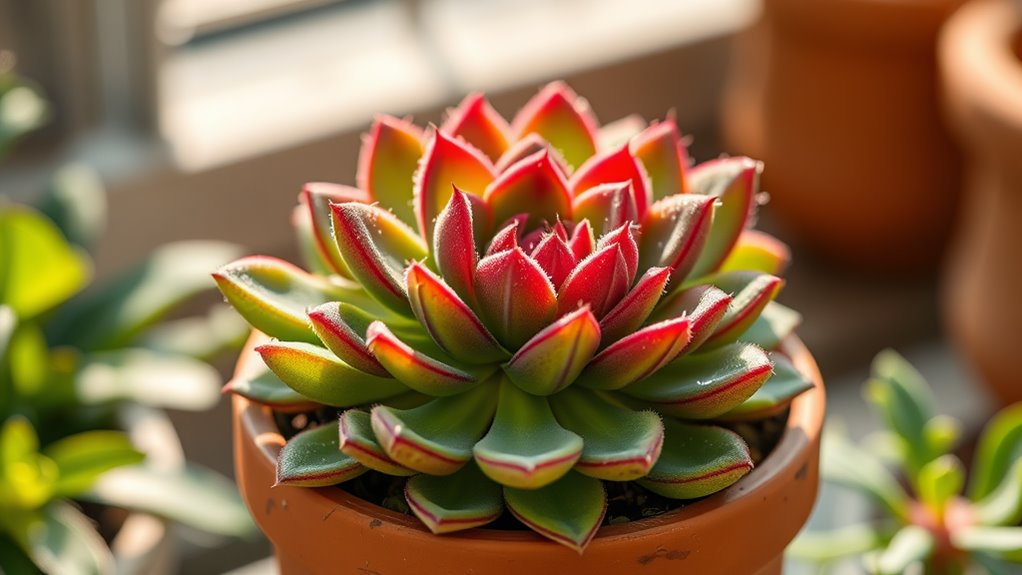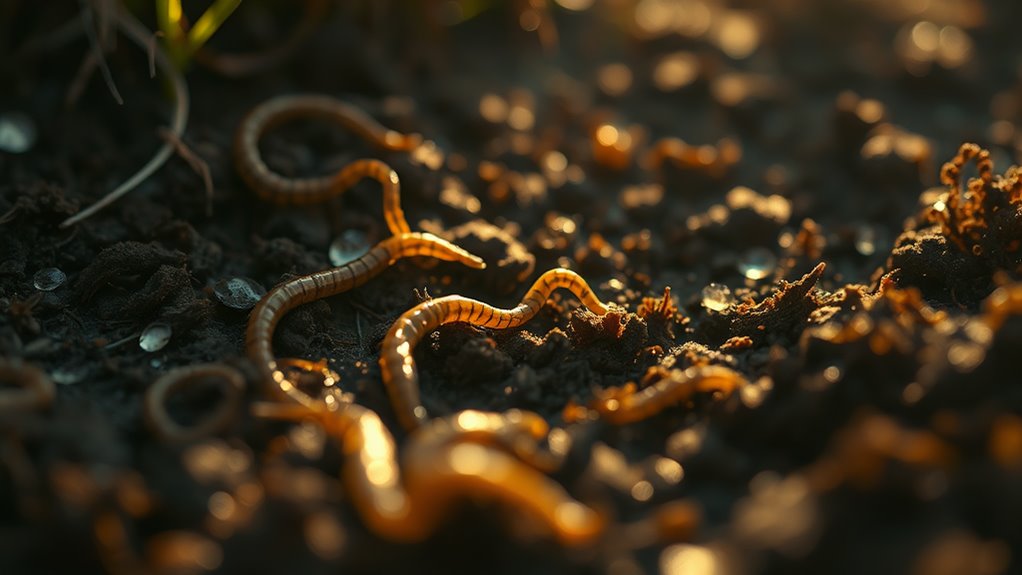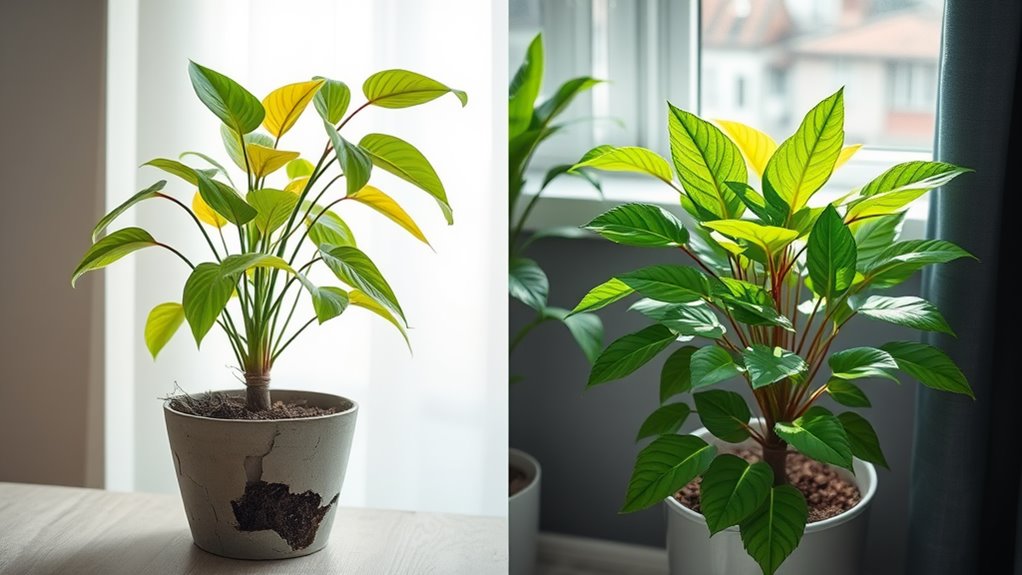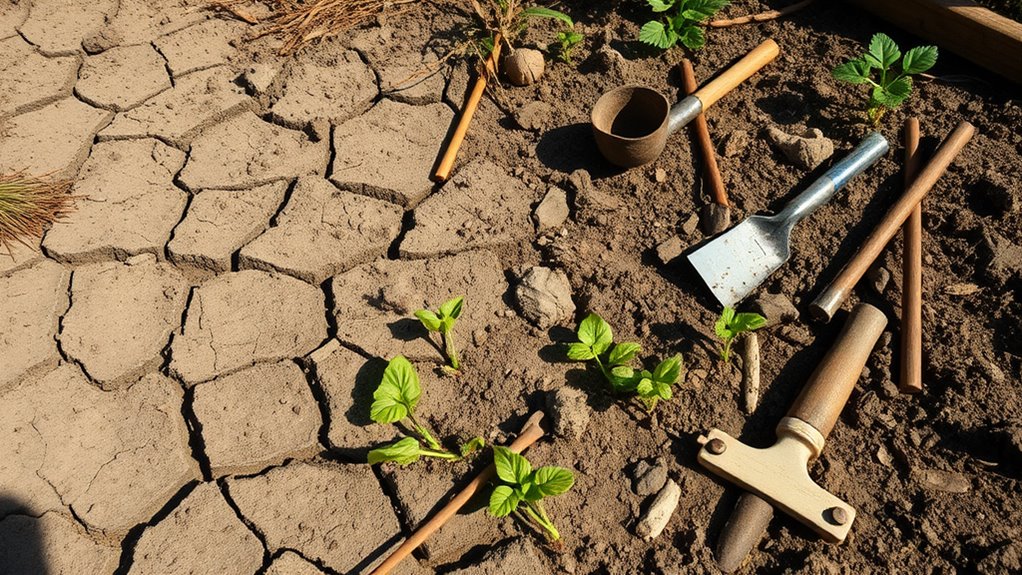What Happens When You Stop Watering Daily (It’s Not What You Think)
When you stop watering your plants daily, you might first notice wilting leaves or yellowing as they adapt, signaling initial stress from reduced moisture. But surprisingly, this shift encourages deeper root growth, boosting drought tolerance and overall resilience, much like building muscle. You’ll end up with healthier, more efficient plants that handle pests better. Explore these benefits further to refine your watering routine and unlock long-term garden success.
Key Takeaways
- Stopping daily watering may cause initial stress like wilting, but it encourages plants to adapt and thrive.
- Roots grow deeper when watering is reduced, leading to stronger, more stable plants.
- Infrequent watering enhances plant resilience, improving drought tolerance and pest resistance.
- Daily watering myths are debunked; overwatering risks like root rot decrease with less frequent hydration.
- Real-world examples show better growth and health in plants like succulents when watering intervals are extended.
The Initial Impact on Plant Health
When you stop watering your plants daily, they’ll quickly show signs of stress as their leaves begin to wilt from reduced water uptake.
Changing your watering schedule disrupts the root zone’s moisture levels, leading to rapid dehydration that hampers photosynthesis and nutrient transport.
You’ll observe yellowing leaves and stunted growth as cells lose turgor pressure, making plants more vulnerable to pests.
Scientifically, this initial phase involves osmotic stress, so check soil moisture regularly to gauge the impact and prevent irreversible damage during the adjustment period. Moreover, incorporating heat-proof watering tips can help maintain hydration during scorching weather.
However, by implementing expert watering techniques, you can better optimize plant hydration and promote healthier growth in the long term.
Surprising Benefits of Infrequent Watering
When you stop watering your plants daily, you’ll notice deeper root growth as roots seek moisture farther down. By adopting deep watering, you can water effectively once a week to promote stronger root systems.
This change also enhances your plant’s resilience, helping it better withstand droughts and pests.
Plus, infrequent watering improves water efficiency, allowing you to conserve resources while maintaining healthy growth.
Incorporating effective watering timing can further enhance these benefits by optimizing your garden’s overall health.
Deeper Root Growth
One of the most surprising benefits of infrequent watering is that your plants’ roots grow deeper to access hidden moisture reserves. This process, driven by the plant’s natural response to drought stress, encourages roots to extend further into the soil, seeking water and nutrients from lower layers. Scientifically, studies show infrequent watering increases root depth by up to 50% in many species, enhancing soil exploration and mineral uptake.
| Root Aspect | With Daily Watering | With Infrequent Watering |
|---|---|---|
| Depth | Shallow (e.g., 20 cm) | Deeper (e.g., 1 meter) |
| Spread | Limited | Extensive |
| Nutrient Access | Surface-only | Subsoil reserves |
Enhanced Plant Resilience
Infrequent watering builds your plants’ resilience by training them to cope with stress, much like a workout strengthens muscles.
You’ll notice your plants adapt by enhancing their drought tolerance, producing protective proteins and antioxidants that shield against environmental challenges.
Scientifically, this process, called acclimation, boosts survival rates during dry spells or heatwaves.
For practical care, test this by gradually extending intervals between waterings; observe how your plants recover faster from stressors.
This resilience not only hardens them but also promotes overall vigor, making your garden more robust and self-reliant.
Improved Water Efficiency
You’ll notice that the resilience gained from less frequent watering also sharpens your plants’ water efficiency, allowing them to make the most of every drop.
As roots delve deeper and tissues adapt, your plants optimize hydration for better survival.
-
Deeper root growth: Your plants extend roots to access subsurface moisture, reducing reliance on surface water and boosting drought resistance.
-
Enhanced water storage: They accumulate more water in cells, minimizing evaporation and sustaining growth during dry spells.
-
Improved nutrient uptake: Efficient water use enables better absorption of minerals, leading to stronger, more productive plants with less waste.
Debunking Daily Watering Myths
Many gardeners believe daily watering is essential for plant health, but this myth overlooks the science of soil moisture and root systems. Common soil myths often lead to misconceptions about how soil interacts with water in gardening practices.
In reality, most plants adapt to natural cycles, where overwatering disrupts balance by causing root rot and shallow growth. You might think constant moisture wards off stress, but it leaches nutrients and promotes fungal issues.
Scientifically, soil composition determines water retention—sandy types dry faster, needing less frequent hydration, while clay holds moisture longer.
Test your soil before watering; use a finger or meter to check depth, ensuring you water only when dry, promoting efficiency.
Additionally, recognizing signs of overwatering early can prevent long-term damage to your plants.
How Plants Build Resilience Over Time
When you stop watering your plants daily, you’re encouraging root deepening, which helps them access water from deeper soil layers.
This process also fosters stress adaptation benefits, allowing your plants to better handle dry periods and environmental challenges.
Over time, these changes enhance long-term hardiness, making your garden more resilient to fluctuations in water availability. Moreover, incorporating backyard materials can help naturally enrich the soil to support this resilience.
Additionally, integrating soil preparation techniques ensures that the soil structure supports deeper root growth and overall plant vitality.
Root Deepening Effects
As plants adapt to infrequent watering, their roots delve deeper into the soil in search of moisture, fostering greater resilience.
You’ll see your plants develop stronger root systems, which enhance their ability to thrive in varying conditions without constant care.
-
Deeper penetration: Your plant’s roots extend further, tapping into moisture-rich subsoil layers that surface watering overlooks.
-
Improved stability: These elongated roots anchor plants more firmly, reducing vulnerability to wind or soil erosion.
-
Efficient exploration: Roots branch out widely underground, allowing better access to nutrients and water reserves for sustained health.
Stress Adaptation Benefits
With deeper roots established from less frequent watering, your plants actively build resilience by adapting to stress, such as drought, which toughens their systems for long-term survival. This process enhances your plants’ ability to produce protective compounds and improve resource efficiency, making them more robust against environmental challenges.
| Stress Factor | Adaptation Mechanism | Key Benefit |
|---|---|---|
| Drought | Enhanced root development | Better water absorption |
| Heat exposure | Increased antioxidant production | Reduced cellular damage |
| Nutrient deficiency | Optimized uptake mechanisms | Efficient resource use |
| Wind stress | Strengthened structural growth | Improved stability |
Long-Term Hardiness
Plants build long-term hardiness by repeatedly adapting to stressors like infrequent watering, which strengthens their overall resilience over time.
As you reduce watering frequency, you’ll encourage deeper root growth and improved stress tolerance, leading to plants that thrive in challenging conditions without constant care.
-
Your plants develop extensive root systems that explore soil for water, enhancing drought survival.
-
They build stronger cellular structures, increasing resistance to pests, diseases, and temperature fluctuations.
Over time, this fosters a self-reliant garden, where you’ll observe sustained health and reduced maintenance needs.
Key Signs of Overwatering to Watch For
Overwatering your plants can quickly lead to visible distress, so you’ll notice yellowing leaves, wilting despite moist soil, and a foul odor from the roots as early warnings.
You’ll also spot root rot, where roots turn brown and slimy due to fungal invasion, disrupting water absorption.
Edema appears as blister-like bumps on leaves from excess moisture, while stems may soften and collapse from oxygen-starved tissues.
Scientifically, these symptoms stem from anaerobic conditions fostering pathogens, so regularly inspect roots and soil to intervene before irreversible damage occurs.
Early detection maintains plant health effectively.
Optimal Watering Intervals for Various Species
You’ve got to tailor your watering schedule to each plant’s needs, starting with cacti that thrive on infrequent intervals of every 2-4 weeks to mimic their natural arid environments.
For ferns, you’re aiming for more regular timing, watering every 1-3 days to maintain the consistent moisture they require for healthy growth.
Understanding these intervals helps you prevent stress and promote vitality in your plants. Additionally, proper indoor lighting plays a key role in supporting overall plant health and growth.
To enhance your indoor gardening, incorporating fresh herbs can provide flavorful year-round additions to your cooking routines.
Cacti Watering Intervals
While cacti thrive in arid conditions, finding the optimal watering interval for your species can make all the difference in preventing root rot or dehydration.
You’ll need to consider factors like climate, soil type, and plant maturity to avoid extremes.
-
For barrel cacti****, water every 2-4 weeks in warm weather, allowing soil to dry completely to mimic desert patterns and promote healthy growth.
-
For prickly pear****, aim for 1-3 weeks based on humidity; overwatering leads to fungal issues, so check soil moisture first.
-
For smaller species like hedgehog cacti****, extend intervals to 3-6 weeks in cooler months, ensuring deep watering to encourage robust root development.
Ferns Optimal Timing
Ferns demand regular moisture to thrive, unlike the sparse watering routines of cacti. You must tailor your watering schedule to the species and conditions.
For Boston ferns, water every 1-2 days in dry environments to maintain humidity; bird’s nest ferns prefer every 3-5 days in moist settings. Maidenhair ferns need daily misting and watering to avoid wilting.
Scientifically, monitor soil moisture levels—water when the top inch feels dry—to prevent root rot or dehydration. Factors like light, temperature, and humidity dictate these intervals, so you adjust based on your plant’s response for optimal health.
Real-World Case Studies of Watering Changes
To explore the effects of altering watering routines, you’ll find real-world case studies offer valuable insights into plant responses.
These examples show how everyday changes can lead to surprising adaptations without daily watering. By adopting smart watering techniques, gardeners can enhance their plants’ resilience and overall health.
-
Succulents in a dry climate: You switched to weekly watering; your plants developed deeper roots, thriving with less stress and maintaining vibrant growth.
-
Tomato plants in a garden: Reducing to every three days, you noticed improved fruit quality as they conserved energy, yielding juicier tomatoes with fewer diseases.
-
Indoor ferns at home: When you extended intervals, your ferns adjusted by slowing growth initially, then rebounding with healthier foliage once established.
Additionally, these watering adjustments can reduce pest vulnerability by fostering resilient plants, much like strategies in natural pest control.
Science Behind Plant Water Requirements
Plants adapt to watering changes through underlying biological mechanisms that govern their water use.
You see, your plants’ roots absorb water via osmosis, maintaining turgor pressure for structural support and nutrient uptake. Stomata on leaves regulate transpiration, balancing water loss with carbon dioxide intake for photosynthesis.
When you reduce watering, plants activate drought responses like closing stomata or producing stress proteins, conserving resources. This adaptation minimizes damage, as plants evolved in variable environments, optimizing survival through efficient water storage in tissues like vacuoles.
Understanding these processes helps you appreciate your plants’ resilience scientifically.
Practical Tips for Adjusting Your Routine
As you grasp the science of plant water needs, start by monitoring your soil’s moisture levels weekly to fine-tune your watering schedule. This involves checking topsoil and deeper layers for even hydration, preventing root issues like rot or stress.
By integrating data on soil type and climate, you’ll create a sustainable routine that matches plant demands.
- Use a digital moisture meter to measure soil water content accurately, guiding your decisions with real-time data.
- Adjust watering intervals based on environmental factors like temperature and rainfall, ensuring efficient resource use.
- Observe plant indicators, such as leaf wilting or color changes, to calibrate your schedule scientifically and maintain balance.
Long-Term Growth Enhancements From Reduced Watering
While you might initially doubt the benefits, reducing watering frequency encourages your plants to develop deeper root systems, enhancing their resilience to drought and improving overall nutrient absorption for sustained health.
You’ll notice stronger growth as roots explore soil more efficiently, accessing minerals that promote robust foliage and blooms.
Scientifically, this mimics natural conditions, where plants adapt by increasing root mass, leading to better water retention and disease resistance.
Over time, you’re fostering a more self-sufficient garden, yielding healthier, more productive plants with minimal intervention.
Track progress by monitoring soil moisture and plant vigor regularly.





